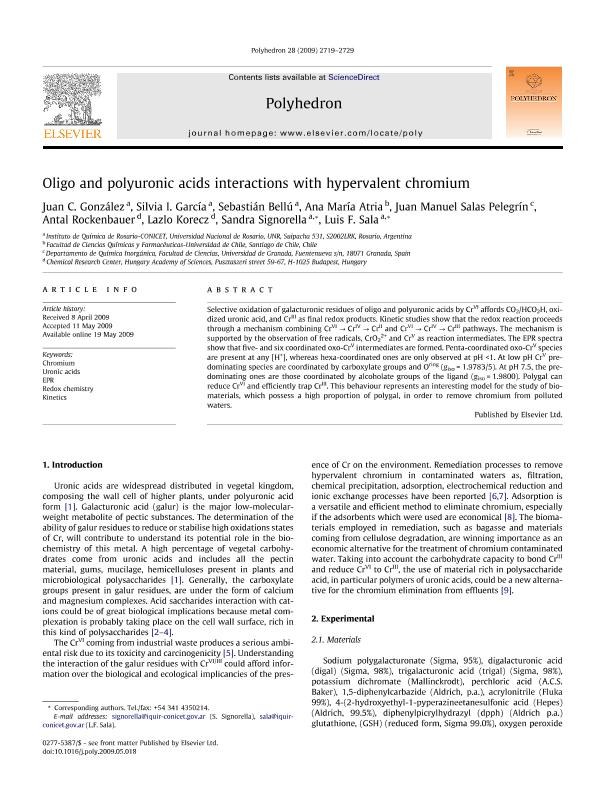Artículo
Oligo and polyuronic acids interactions with hypervalent chromium
González, Juan Carlos; García, Silvia Isabel; Bellú, Sebastián Eduardo ; Atria, Ana María; Salas Pelegrín, Juan Manuel; Rockenbauer, Antal; Korecz, Lazlo; Signorella, Sandra Rosanna
; Atria, Ana María; Salas Pelegrín, Juan Manuel; Rockenbauer, Antal; Korecz, Lazlo; Signorella, Sandra Rosanna ; Sala, Luis Federico
; Sala, Luis Federico
 ; Atria, Ana María; Salas Pelegrín, Juan Manuel; Rockenbauer, Antal; Korecz, Lazlo; Signorella, Sandra Rosanna
; Atria, Ana María; Salas Pelegrín, Juan Manuel; Rockenbauer, Antal; Korecz, Lazlo; Signorella, Sandra Rosanna ; Sala, Luis Federico
; Sala, Luis Federico
Fecha de publicación:
09/2009
Editorial:
Pergamon-Elsevier Science Ltd
Revista:
Polyhedron
ISSN:
0277-5387
Idioma:
Inglés
Tipo de recurso:
Artículo publicado
Clasificación temática:
Resumen
Selective oxidation of galacturonic residues of oligo and polyuronic acids by CrVI affords CO2/HCO2H, oxidized uronic acid, and CrIII as final redox products. Kinetic studies show that the redox reaction proceeds through a mechanism combining CrVI → CrIV → CrII and CrVI → CrIV → CrIII pathways. The mechanism is supported by the observation of free radicals, CrO22+ and CrV as reaction intermediates. The EPR spectra show that five- and six coordinated oxo-CrV intermediates are formed. Penta-coordinated oxo-CrV species are present at any [H+], whereas hexa-coordinated ones are only observed at pH <1. At low pH CrV predominating species are coordinated by carboxylate groups and Oring (giso = 1.9783/5). At pH 7.5, the predominating ones are those coordinated by alcoholate groups of the ligand (giso = 1.9800). Polygal can reduce CrVI and efficiently trap CrIII. This behaviour represents an interesting model for the study of biomaterials, which possess a high proportion of polygal, in order to remove chromium from polluted waters.
Palabras clave:
CHROMIUM
,
EPR
,
KINETICS
,
REDOX CHEMISTRY
,
URONIC ACIDS
Archivos asociados
Licencia
Identificadores
Colecciones
Articulos(IQUIR)
Articulos de INST.DE QUIMICA ROSARIO
Articulos de INST.DE QUIMICA ROSARIO
Citación
González, Juan Carlos; García, Silvia Isabel; Bellú, Sebastián Eduardo; Atria, Ana María; Salas Pelegrín, Juan Manuel; et al.; Oligo and polyuronic acids interactions with hypervalent chromium; Pergamon-Elsevier Science Ltd; Polyhedron; 28; 13; 9-2009; 2719-2729
Compartir
Altmétricas



